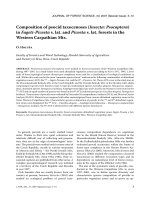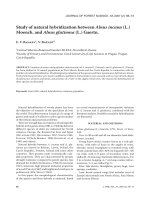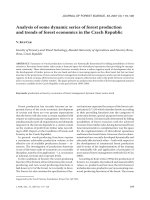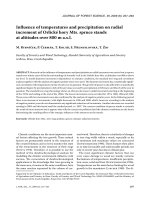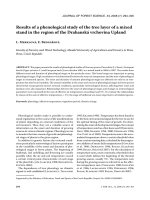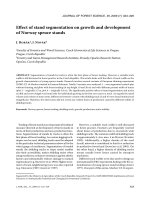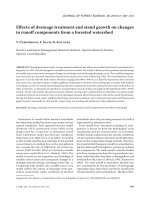Báo cáo lâm nghiệp: " Influence of stand density, thinning and elevated CO2 on stem wood density of spruce" pot
Bạn đang xem bản rút gọn của tài liệu. Xem và tải ngay bản đầy đủ của tài liệu tại đây (224.82 KB, 6 trang )
400 J. FOR. SCI., 53, 2007 (9): 400–405
JOURNAL OF FOREST SCIENCE, 53, 2007 (9): 400–405
Stem wood density (SWD) is the most important
determinant of the wood quality. It allows estimation
of biomass and carbon mass contained in terrestrial
vegetation (F 1997). e SWD is defined as
the dry mass to fresh volume ratio and ranges typi-
cally within the interval from 0.1 to 1 g/cm
3
(R-
2001). SWD depends mainly on the cell size and
the cell wall thickness. Specifically, SWD of forest
trees is influenced by many factors. ere are physi-
cal factors influencing SWD – weight of the crown,
ice or snow loading. From the abiotic factors – soil
moisture is recognized as a major factor controlling
wood properties (H et al. 2002). Air tem-
perature and soil type are the other significant fac-
tors (R 2001), which depend on latitude and
altitude. us SWD markedly decrease with latitude
and altitude as well (S et al. 2005). In
response to nitrogen fertilization, SWD either de-
clines or remains constant (F 1997).
Generally, SWD shows higher values compared to
the branches (P, D Z 1980). SWD of
conifers varies directly with age in the radial direc-
tion and inversely with vertical direction. us, the
highest SWD values occur in outer rings in lower
stem parts and decreases from the bark inward and
from the stem-base upward to the tree top (P-
, D Z 1980).
In most cases, elevated CO
2
induce enhanced
wood density. Compared to natural growing condi-
tions, a doubling of air’s CO
2
concentration would
increase wood density of Norway spruce trees about
2–5% (M et al. 2002). K et al.
(2003) states that the increases in latewood density
and maximum density in response to elevated CO
2
Supported by the Ministry of Environment of the Czech Republic, Project No. VaV/640/18/03, the Ministry of Education,
Youth and Sports of the Czech Republic, Project No. 2B06068, and the Research Intention of ISBE AS CR, Project No.
AV0Z60870520.
Influence of stand density, thinning and elevated CO
2
on stem wood density of spruce
I. T
1
, R. P
1
, M. V. M
1,2
1
Laboratory of Plants Ecological Physiology, Institute of Systems Biology and Ecology,
Academy of Sciences of the Czech Republic, Brno, Czech Republic
2
Faculty of Forestry and Wood Technology, Mendel University of Agriculture and Forestry Brno,
Brno, Czech Republic
ABSTRACT: Stem wood density (SWD) of young Norway spruce trees (Picea abies [L.] Karst.) growing at ambient
(A variant, 350 µmol(CO
2
)/mol) and elevated (E variant, A + 350 µmol(CO
2
)/mol) atmospheric CO
2
concentration inside
of the glass domes with adjustable windows was estimated after six and eight years of the cultivation. Stand density of
two subvariants (s – sparse with ca 5,000 trees/ha and d – dense with ca 10,000 trees/ha) and thinning impact (intensity
of 27%) on SWD and its variation along the stem vertical profile were investigated. After six years of CO
2
fumigation,
stems of sparse subvariant had about 10% lower values of SWD comparing to dense ones, although the difference was
not statistically significant. In 2004 (two years after thinning), the SWD values were higher in all subvariants along
the whole stem vertical profile. is increase was more obvious in E variant (about 6% in d subvariant and only 3% in
s subvariant). e highest increase of SWD values was found in Ed subvariant, particularly in the middle stem part
(about 8%, statistically significant increase).
Keywords: elevated CO
2
; Picea abies; stand density; stem wood density; thinning
J. FOR. SCI., 53, 2007 (9): 400–405 401
may imply improvements in wood strength proper-
ties. Variations in environmental conditions induce
unequal response of wood density to elevated CO
2
.
For example, at ambient temperatures, approxi-
mately 60% increase of the air’s CO
2
concentration
significantly enhance latewood density (by 27%) and
maximum wood density (by 11%), while elevated-
temperature conditions enhance less significantly
latewood density (by 25%) and, in contrary, more
significantly maximum wood density (by 15%)
(B et al. 2002). ese changes lead to mean
overall CO
2
– induced wood density increases of
2.8% at the ambient-temperature and 5.6% at the
elevated-temperature (B et al. 2002). Fur-
thermore, elevated atmospheric CO
2
concentration
increase wood toughness of spruce seedlings grown
on acidic soils by 12 and 18% under low and high
levels of nitrogen deposition, respectively. Elevated
atmospheric CO
2
also increase the same mechani-
cal wood properties in spruce seedlings grown on
calcareous soils by about 17 and 14% under low and
high levels of nitrogen deposition (B et al.
2002).
e objectives of this study were:
(a) to evaluate an influence of elevated atmospheric
CO
2
concentration on SWD,
(b) to describe the changes of SWD values along the
stem vertical profile,
(c) to investigate changes of SWD with respect to
stand density and thinning.
MATERIALS AND METHODS
Site and stand description: ere were two vari-
ants of glass domes with adjustable windows (DAW)
– ambient (A, 350 µmol(CO
2
)/mol) and elevated
(E, A + 350 µmol(CO
2
)/mol) – established a for
simulation of elevated atmospheric CO
2
concen-
tration at the Experimental Research Site Bílý Kříž
(Czech Republic, 49°30´N, 18°32´E, 908 m a.s.l.) in
the Beskydy Mts. (for detail description see U
et al. 2001).
Both variants of artificially established pure stands
of Norway spruce (Picea abies [L.] Karst.) showed
the identical arrangements of the tree spacing (P-
et al. 2001), which enabled to distinguish the
two subvariants: sparse (s, ca 5,000 trees/ha) and
dense (d, ca 10,000 trees/ha). Total number of trees
per variant in each DAW was 56. e trees were
planted at the age of 10–12 years in autumn 1996.
Sampling procedure: In 2002, the first schematic
thinning (intensity of 27%) was carried out. After
the two years, the next one (intensity of 35%) was
performed. us, seven trees per subvariant, i.e.
ambient/elevated sparse/dense, were analyzed in
2002 and 2004, respectively. SWD was obtained
for chosen stem discs that were cut at the middle
parts of internodial sections under the 3
rd
, 5
th
, and
the 7
th
whorl (t
3
, t
5
, t
7
), and in the one tenth of tree
height (Ht
1/10
) (Table 1). Fresh stem discs volume was
measured as a volume of cylinder. Afterwards, stem
discs were dried for 48 hours in 105°C. After drying,
dry weight was precisely estimated (balance model
1405 B MP8-1, Sartorius, Germany). en, SWD
was calculated using the common formula for basic
wood density calculation (R 2001). SWD of
the stem disc t
3
was assorted to block of internodial
sections from the tree top to the t
3
section, SWD of
t
5
disc to sections t
4
+ t
5
, SWD of t
7
disc to sections
t
6
+ t
7
and SWD of disc from 1/10 of H to internodial
sections t
8
and below.
Methodology for stem volume calculation was
based on the length of internodial section and its
middle cross-sectional circle area measurement.
SWD of tree was calculated as the weighted average
(according to length of internodial sections).
Processing of statistical values: One-way and
two-way ANOVA were used for detection of statis-
tically significant differences (SSD, not significant =
NS). All data were tested on normality and homoge-
Table 1. Position of stem discs in stem vertical profile grown in elevated (E) and ambient (A) concentration of CO
2
and sparse
(s) and dense (d) subvariant; Ht – total tree height, Ht
3,5,7
– tree height from the tree base to the appropriate whorl (low index
indicates whorl), Ht
1/10
– tree height in one tenth of the tree height. Numbers in bracket mean relative height
Subvariant
(m)
2002 2004
As Ad Es Ed As Ad Es Ed
Ht 3.66 3.37 3.23 3.27 4.36 4.59 5.62 4.94
Ht
3
2.09 (57%) 1.81 (54%) 1.85 (57%) 2.18 (67%) 2.73 (63%) 2.83 (62%) 3.13 (56%) 2.77 (56%)
Ht
5
1.45 (40%) 1.09 (32%) 1.42 (44%) 1.51 (46%) 2.08 (48%) 2.14 (47%) 2.43 (43%) 2.04 (41%)
Ht
7
0.87 (24%) 0.55 (16%) 0.79 (24%) 0.90 (28%) 1.26 (29%) 1.63 (36%) 1.51 (27%) 1.48 (30%)
Ht
1/10
0.37 (10%) 0.34 (10%) 0.32 (10%) 0.33 (10%) 0.44 (10%) 0.46 (10%) 0.56 (10%) 0.49 (10%)
402 J. FOR. SCI., 53, 2007 (9): 400–405
neity (S-W and Lewene tests; differences were tested
on the level α = 0.05). Scheffe and Duncan test were
used for detection of SSD. Statistica software (Stat-
Soft Inc., Tulsa USA) was performed for statistical
analysis.
RESULTS AND DISCUSSION
After six years of the cultivation under two differ-
ent CO
2
concentrations, A ambient and E elevated
average stem wood density SWD was comparable
in both variants (A > E, 358 versus 351 kg/m
3
, NS).
After schematic thinning (i.e. two years later), SWD
increased about 60 kg/m
3
in E variant and 30 kg/m
3
in A variant (Fig. 1). us, SWD of young Norway
spruce trees grown under elevated atmospheric CO
2
was higher on average about 6% comparing to ambi-
ent conditions (412 versus 390 kg/m
3
, NS, P = 0.055).
inning also affected the stem volume (increase
about 13% in E variant) and stem biomass (increase
about 17% in E variant). ese results are consistent
with the results of M et al. (2002), who pre-
sented increase of SWD in Norway spruce trees up to
5% under the doubling of atmospheric CO
2
(results
are from 12 year long experiment without the effect
of thinning). A positive correlation between atmos-
pheric CO
2
and SWD for Pinus radiata and Pinus
sylvestris was also described by H
et al. (1996), C et al. (1990), C and
J (2002). However, Pinus taeda did not respond
to elevated CO
2
unambiguously. SWD of this species
was increased (D 1987) or decreased (O
et al. 2001) and also remained stable (M,
D 1997; T et al. 1999; R-
2001). ese inconsistent results obtained for
individual coniferous species can be also caused by
differences in cultivation design and also in fumiga-
tion duration.
Presented values of SWD distinctively showed
higher values (about 10%) for trees grown in more
dense spacing (two times denser comparing to sparse
one) for both investigated years (i.e. before and after
thinning). Considering spacing of subvariants, the
higher SWD values were observed in both E and
A subvariants (Es > As, by 3%, NS; Ed > Ad, by 6%,
SSD). is observation supports a phenomenon of
the sink strength effect described by U (2003).
SWD was found to be higher in d subvariant grow-
ing under elevated CO
2
, therefore enhanced CO
2
effect seems to be forced by the stand density. e
growth competition between trees of the d subvari-
ant caused more probably sink strength, so the CO
2
410
400
390
380
370
360
350
340
330
320
310
Stem wood density (kg/m
3
)
440
430
420
410
400
390
380
370
360
350
340
330
(a) (b)
A E A E
Variant Variant
sparse dense
Fig. 1. Average stem wood density in elevated (E) and ambient (A) concentration of CO
2
and sparse (s) and dense (d) subvariant
independent from vertical stem profile; (a) 2002, i.e. after 6 years of the cultivation and (b) 2004, i.e. after 8 years of the cultiva-
tion and 2 years after thinning. Stars denote statistical significant difference
J. FOR. SCI., 53, 2007 (9): 400–405 403
effect was more obvious. ese results are in ac-
cordance with findings of L (1996), who
described strong effects of thinning on the Norway
spruce trees SWD values.
SWD for European Norway spruce ranges on av-
erage within the interval 320–420 kg/m
3
(H
1989). us, SWD values obtained in our experiment
for elevated CO
2
treatment became close to upper
interval limit of natural values.
Before the thinning, the SWD values alongside
the whole stem as well as the stem biomass (SB) and
stem volume (V), were comparable for both CO
2
variants. After thinning, the SWD values increased
from 358 to 390 kg/m
3
in A variant and from 351 to
411 kg/m
3
in E variant. After the thinning, SSD were
found among SWD values in the middle parts of the
stem vertical profile (i.e. between 5 and 7 whorl).
e average SWD in the upper part of the crown
was 373 kg/m
3
in A variant compared to 346 kg/m
3
in E variant (Fig. 2). e highest SWD occurred at
the stem-base and it was comparable with the SWD
of upper part of the stem as pointed also P
et al. (1980).
Before the thinning, the average SWD at the stem
base gained value of 388 and 367 kg/m
3
in A and E
variants, respectively. After thinning, these values
increased up to 393 and 417 kg/m
3
, respectively.
CONCLUSION
e wood densities alongside the whole stem were
comparable in the both ambient and elevated CO
2
treatments; therefore just elevated CO
2
had no sig-
nificant effect on the stem wood density of Norway
spruce after six years of cultivation. e thinning
(tree reduction of 27%) resulted in the significant
increase of the stem wood density along the whole
stem vertical profile under elevated CO
2
, especially
280 320 360 400 440 480 280 320 360 400 440 480
2002 2004
Stem wood density (kg/m
3
)
As Ad Es Ed
(a)
(b)
Vertical stem profile (whorl)
3
5
7
1/10h
3
5
7
1/10h
Fig. 2. Stem wood density in subvariants in elevated (E) and ambient (A) concentration of CO
2
and sparse (s) and dense (d)
subvariant within vertical stem profile in (a) 2002 and (b) 2004. Whiskers denote standard deviation. Letters denote homog-
enous groups
a
ab
a
b
a
a
a
a
a
a
a
a
b
ab
a
a
a
a
a
a
a
a
a
a
a
a
a
a
a
a
a
a
404 J. FOR. SCI., 53, 2007 (9): 400–405
in the middle part of stem. Participation of elevated
CO
2
and thinning had a positive effect on stem wood
density.
R ef er en c es
BEISMANN H., SCHWEINGRUBER F., SPECK T., KORNER
C., 2002. Mechanical properties of spruce and beech wood
grown in elevated CO
2
. Trees – Structure and Function,
16: 511–518.
CEULEMANS R., JACH M.E. et al., 2002. Elevated atmo-
spheric CO
2
alters wood production, wood quality and
wood strength of Scots pine (Pinus sylvestris L.) after three
years of enrichment. Global Change Biology, 8: 153–162.
CONROY J.P., MILHAM P.J., MAZUR M. et al., 1990.
Growth, dry-weight portioning and wood properties of
Pinus radiata after 2 years of enrichment. Plant, Cell and
Environment, 13: 329–337.
DOYLE T.W., 1987. Seedling response to CO
2
enrichment
under stressed and non-stressed conditions. In: JACOBY
G.C., HORNBECK J.W. (eds.), Proceedings of the Inter-
national Symposium on Ecological Aspects of Tree-Ring
Analysis. Springfield, National Technical Information
Service: 501–510.
FEARNSIDE P.M., 1997. Wood density for estimating forest
biomass in Brazilian Amazonia. Forest Ecology and Man-
agement, 90: 59–87.
HAKKILA P., 1989. Investigations of the basic density of
Finnish pine, spruce and birch wood. Communicationes
Instituti Forestalis Fenniae, 75: 60.
HANSMANN C., WIMMER W.G.R., TEICHINGER A., 2002.
Permeability of wood – A review. Drevársky výskum, 47:
1–16.
HÄTTENSCHWILER S., SCHWEINGRUBER F.H., KÖRNER
C., 1996. Tree ring responses to elevated CO
2
and increased
N deposition in Picea abies. Plant, Cell and Environment,
19: 1369–1378.
KILPELAINEN A., PELTOLA H., RYYPPO A., SAUVALA K.,
LAITINEN K., KELLOMAKI S., 2003. Wood properties of
Scots pines (Pinus sylvestris) grown at elevated tempera-
ture and carbon dioxide concentration. Tree Physiology,
23: 889–897.
LINDSTROM H., 1996. Basic density of Norway spruce.
Predicted by stem taper, mean growth ring width, and fac-
tors related to crown development. Wood Fiber Science,
28: 240–251.
MAKINEN H., SARANPAA P., LINDER S., 2002. Wood-
density variation of Norway spruce in relation to nutrient
optimization and fiber dimensions. Canadian Journal of
Forest Research, 32: 185–194.
MURTHY R., DOUGHERTY P.M., 1997. Effect of car-
bon dioxide fertilization and irrigation on loblolly pine
branch morphology. Trees – Structure and Function, 11:
485–493.
OREN R. et al., 2001. Soil fertility limits carbon sequestra-
tion by forest ecosystems in a CO
2
enriched atmosphere.
Nature, 411: 469–472.
PANSHIN A.J., DE ZEEUW C., 1980. Textbook of Wood Tech-
nology. 4
th
ed. New York, Mc-Graw-Hill: 176–177, 207.
POKORNÝ R. et al., 2001. Growth and transpiration of
Norway spruce trees under atmosphere with elevated CO
2
concentration. Ekológia (Bratislava), 20: 14–28.
RODERICK M.L., 2001. Linking wood density with tree
growth and environment: a theoretical analysis based on
the motion of water. New Phytology, 149: 473–485.
SOPUSHYNSKYY I., VINTONIV I., TEISCHINGER A., MI-
CHALAK R., 2005. e influence of site factors on wood
density and moisture content of beech in the Ukrainian
Carpathians. Wood Research, 50: 43–49.
TELEWSKI F.W., SWANSON R.T., STRAIN B.R., BURNS
J.M., 1999. Wood properties and ring width responses to
long-term atmospheric CO
2
enrichment in field-grown
loblolly pine (Pinus taeda L.). Plant, Cell and Environment,
22: 213–219.
URBAN O. et al., 2001. Glass domes with adjustable windows:
A novel technique for exposing juvenile forest stands to el-
evated CO
2
concentration. Photosynthetica, 39: 395–401.
URBAN O., POKORNÝ R., KALINA J., MAREK M.V., 2003.
Control mechanisms of photosynthetic capacity under el-
evated CO
2
concentration: evidence from three experiments
with Norway spruce trees. Photosynthetica, 41: 69–75.
Received for publication May 21, 2007
Accepted after corrections June 12, 2007
Vliv hustoty porostu, prořezávky a zvýšené koncentrace CO
2
na hustotu dřeva
kmene smrku
ABSTRAKT: Hustota dřeva kmene (SWD) byla stanovena u mladých jedinců smrku ztepilého (Picea abies [L.]
Karst.) kultivovaných po dobu šesti a osmi let v přirozené (varianta A, 350 mol(CO
2
)mol) a zvýšené (varianta E,
A + 350 mol(CO
2
)mol) vzdušné koncentraci CO
2
uvnitř lamelových komor. Byl zkoumán vliv rozdílných hustot
porostu (subvarianty: s – řídká – 5 tisíc ks/ha a d – hustá – 10 tisíc ks/ha) a prořezávky (intenzita 27 %) na SWD
J. FOR. SCI., 53, 2007 (9): 400–405 405
a jeho změny v podélném profilu kmene. Po šesti letech fumigace CO
2
byly hodnoty SWD kmenů řídké subvarianty
v průměru o 10 % nižší ve srovnání s hustou subvariantou. V r. 2004 (dva roky po prořezávce) byla SWD kmenů vyšší
podél celého profilu kmene ve všech subvariantách. Tento nárůst byl výrazný především ve variantě E (v průměru
o 6 % v husté subvariantě a o 3 % v řídké subvariantě). K nejvyššímu nárůstu hodnot SWD kmenů husté subvarianty
E došlo ve střední části kmene (o 8 %, statisticky průkazný rozdíl).
Klíčová slova: zvýšená koncentrace CO
2
; Picea abies; hustota porostu; hustota dřeva kmene; prořezávka
Corresponding author:
Ing. I T, Ph.D., Ústav systémové biologie a ekologie AV ČR, v.v.i., Laboratoř ekologické fyziologie
rostlin, Poříčí 3b, 603 00 Brno, Česká republika
tel./fax: + 420 543 211 560, e-mail:
